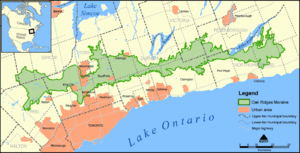Oak Ridges Moraine facts for kids
The Oak Ridges Moraine is a very important natural area in south-central Ontario, Canada. It's a special kind of landform made of hills and valleys. This moraine stretches for about 160 kilometers (100 miles) across Ontario. It goes from Caledon in the west to Rice Lake near Peterborough in the east.
This unique landform was created about 12,000 years ago. Giant sheets of ice, called glaciers, moved across the land and then melted away. As they moved, they pushed and left behind huge amounts of sand, gravel, and clay. This created the rolling hills and deep valleys we see today. The Oak Ridges Moraine is super important for nature and for people. It's also a place where there's been a lot of discussion about how to protect it from new buildings and towns.
Contents
How the Moraine Was Formed
The Oak Ridges Moraine was mostly formed during the last Ice Age, called the Late Wisconsin glacial period. Imagine two huge ice sheets. One was over what is now Lake Ontario and the other was over Lake Simcoe. As these glaciers slowly melted, water flowed between them. This water carried lots of sand, gravel, and rocks.
These materials were dropped in layers, building up the moraine. In some places, these layers are as thick as 150 meters (500 feet)! The moraine grew from west to east. This means the western parts got more material earlier than the eastern parts.
The moraine is made up of four main sections, like big wedges. These are called Albion, Uxbridge, Pontypool, and Rice Lake. They formed over a relatively short time, maybe just a few hundred years. This is shown by the yearly layers of sediment found in ancient glacial lakes within the moraine.
What Makes the Moraine Special?
The Oak Ridges Moraine is a truly special place because of its unique features. It's not just a collection of hills. It's a vital natural system that supports water, plants, and animals.
Water: The Moraine's Hidden Treasure
The moraine is like a giant sponge. It soaks up rain and melting snow. This water then slowly filters down into underground storage areas called aquifers. These aquifers are a very important source of clean drinking water for many towns and cities nearby.
The moraine also feeds many streams and rivers. These small streams are the "headwaters" for larger rivers that flow into Lake Simcoe, Lake Scugog, and Lake Ontario. Because of this, protecting the moraine means protecting the water for a much larger area.
The moraine has many important water features. These include:
- Streams that flow all the time or only after rain.
- Wetlands, which are like natural filters for water.
- Kettle lakes and ponds, which are small lakes formed by melting ice blocks.
- Areas where underground water comes to the surface, called springs.
Because water is so important here, special rules are in place. The Oak Ridges Moraine Conservation Act says that new buildings must be at least 30 meters (100 feet) away from any water feature. This helps keep the water clean and healthy.
Amazing Plants and Animals
The Oak Ridges Moraine is home to a huge variety of plants and animals. It's a place with high biodiversity. The different landscapes, like forests, wetlands, and lakes, create many different habitats.
You can find one of the last large connected forests in southern Ontario here. This forest provides a safe home for many creatures. Some of the plants and animals living on the moraine are "species at risk." This means they are rare or threatened in Canada and Ontario.
Some of these special species include:
- The West Virginia white butterfly.
- The Jefferson salamander.
- The red-shouldered hawk.
- The American ginseng plant.
The moraine also has unique ecosystems. These include wetlands that look like those found in northern forests. There are also small areas of tallgrass prairie and oak-pine savanna. These types of habitats are very rare around the world. A great example of the moraine's natural beauty can be found in the Happy Valley Forests.
Protecting the Moraine
People have known the moraine was special for a long time. But it wasn't until the 1990s that protecting it became a big public issue. Groups like the Save the Oak Ridges Moraine (STORM) Coalition were formed to speak up for the moraine.
In 1991, the government started looking into ways to plan for the moraine's future. But for a while, local governments made their own decisions. This led to a lot of new buildings being planned on parts of the moraine.
In 1999, there was a big push to build many new homes in areas like Richmond Hill. This would have meant over 100,000 people living on the moraine. But the government stepped in and announced a ban on new development. This caused a lot of debate and got a lot of attention from the public and the news.
Finally, in 2001, the government put a temporary stop to all new building plans. They created a panel to come up with a new plan for the land. This led to the Oak Ridges Moraine Conservation Act, 2001. This important law divided the moraine into different zones. Each zone has strict rules about what can and cannot be built there.
The Act protected over 92% of the moraine from new large developments. Only projects that already had full approval could go ahead. Even with this law, the discussion about how to balance building with protecting nature continues.
Many groups are working to protect the moraine. The Conservation Authorities Moraine Coalition (CAMC) works to keep the moraine healthy. The Oak Ridges Moraine Land Trust is another group. They buy land or work with landowners to protect parts of the moraine forever. The Nature Conservancy of Canada is also active in protecting important areas like the Happy Valley Forest.
Images for kids





